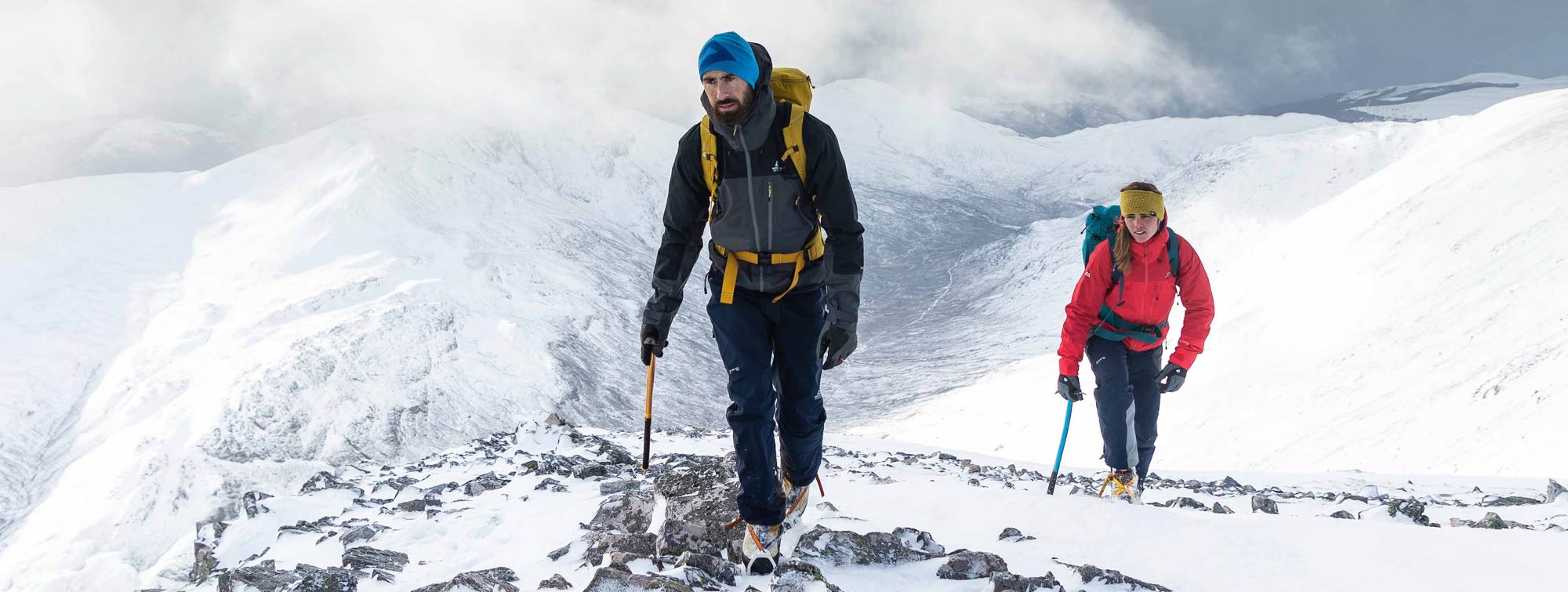Choosing Winter Gloves
Posted by Mark Richardson on Jan 19, 2023

Choosing Winter Gloves
You only have to go outside for ten minutes in cold weather to realise how important a decent pair of gloves is, if you go outside on a mountain for a full day out then your choice of glove could make or break your enjoyment of the day! Windy and wet conditions further exacerbate the problem of keeping your hands warm and comfortable because they rob your hands of heat.
We look at the considerations to make when choosing winter gloves.
Gloves or Mitts?
- Mitts are generally warmer than gloves but the compromise is lack of dexterity.
Mitts are warmer weight for weight because your fingers share warmth and there’s less fabric surface area for heat to escape. They aren’t very dextrous though, so adjusting your rucksack or putting up a tent may be trickier than with a well fitting pair of gloves, though mitts are fine for gripping trekking poles.
Waterproof?
- Most people will need waterproof gloves for winter hiking and backpacking because they are likely to get wet
- Non-waterproof gloves can be more comfortable and dextrous
- You can buy lightweight waterproof over-mitts to get the best of both worlds
For winter walking and hiking in the mountains, you almost certainly need your gloves to be waterproof. Even if it doesn’t rain, if there’s snow on the ground your gloves are likely to get wet at some point during the day, and moisture compromises the ability of the gloves to keep your hands warm and comfortable.
Gloves are made waterproof by inserting a waterproof breathable liner into them, this adds bulk to a glove and therefore makes them less dextrous than an equivalent glove without this liner, also this liner may cause your hands to sweat because the glove isn’t as ‘breathable’. Some people may prefer a warm but highly breathable glove for their particular activity, but most of us will need a fully waterproof glove.
Waterproof Shell Mitts are a way of capturing the benefits of both, they go over non-waterproof gloves when it’s raining.

Down versus Synthetic Insulation?
- Synthetic insulation is more suited to gloves
- Down Mitts are a useful and lightweight addition when camping
Down remains the best insulation weight for weight but to unlock this efficiency the down needs space to ‘loft’ properly, this is difficult to achieve in a glove. It’s easier to do in Mitts and offer an ultralight solution to keeping your hands warm.
Dexterity
- High quality, technical insulation will be less bulky than its equivalent, so the gloves will offer better dexterity
- Thin fabrics will improve dexterity
- Pre-curved fingers remove bulk from the inner face of the fingers offering better dexterity
- A glove that fits properly will improve dexterity - fingers should be a few mm from the end of the glove, if the glove is too large dexterity will be compromised by the excess fabric
Dexterity refers to your ability to handle small items (such as cameras, rucksack straps, tie your laces etc) and without gloves your hands are highly dextrous. Add a glove though and this ability is compromised, add a winter glove and there’s often very little you can do without taking them off.
Generally speaking the warmer the glove, the thicker it is, and the thicker it is the less dexterity you will have when wearing it, but some nuances make some gloves better than others in this respect:
Other solutions – for Dexterity
- Fingerless gloves offer a compromise if you need high dexterity
- You can use fingerless gloves as an inner glove and have an outer mitt when you don’t need the extra dexterity
- Some manufacturers have produced fingerless gloves with a fold over mitt ‘head’ which offer a good solution

Windproof?
- If it’s going to be windy where you are you definitely need windproof gloves otherwise the warmth provided will be severely compromised
- Waterproof Gloves are windproof anyway, but you should check others
Fleecy open-weave gloves may be very warm and comfortable but when the wind gets up it blows the heat away from the skin rendering them much less warm. If you are looking for just a warm pair of gloves check if they are windproof, as this will maintain their performance in windy conditions.
A Gathered Wrist or Cuff?
- A gathered cuff will keep heat in and keep snow and rain out
Check that your gloves have a gathered wrist or cuff, some stretchy material or Velcro fastener, or a cord with a cord-lock. This not only helps keep warmth inside the glove by not allowing it to leak out but it also prevents snow and rain from getting inside the glove causing it to be wet and cold inside.
Some cuffs on non-waterproof gloves are made from knitted fabric to provide an elasticated closure, these tend to hold water, they get wet and can be slow to dry out, and they are not ideal except when it’s not likely to rain.
A Long Cuff?
- A long cuff will prevent snow and rain from getting inside the glove, make sure there’s a closure at the end though
Check that your gloves have a long cuff, this design is really useful for preventing wind and snow from getting inside, however, it must have some form of closure for it to work properly, either an elasticated closure, Velcro or Shock cord.
Inside or outside your waterproof jacket?
Most people will cinch the gloves’ cuff and then slide their waterproof jacket sleeve over it so that any rain runs off. If you have a lightweight waterproof where the sleeves are cut quite slim this may not be possible and you may need a slimmer glove, or cinch it around the waterproof jacket sleeve.

Pre-Curved Fingers?
- Highly insulated gloves should have pre-curved ‘fingers’ to prevent ‘bunching’ of the fabric when you grab things
Highly insulated gloves have thick bulky fingers so it’s important to check if these are ‘pre-curved’, by doing this manufacturers put less fabric on the inside face of the ‘fingers’ so that this doesn’t bunch up when you make a fist. It’s an important comfort consideration, especially if you are using trekking poles or handling an ice axe.
Leather Palms and Finger Tips?
- Leather remains flexible at low temperatures, and gives a good gripn Pre-Curved Fingers?
- Leather is relatively waterproof, breathable, puncture and abrasion resistant making the gloves highly durable
Leather components in cold weather gloves are very popular, leather has some really good properties that make it ideal for this application; it’s tough and hard wearing making it ideal for holding onto trekking poles, ice axes and other ice tools. If you are camping in winter leather gloves will be more durable for camping chores like putting the tent up.
Leather also gives a good grip so it is ideal for using trekking poles and the like. It’s flexible too, so the glove doesn’t feel overly stiff even if there are plenty of leather reinforcements on it. Leather is not waterproof but it is water resistant and the waterproofing of the glove comes from the insert, not the surface fabric of the glove.
Other Features?
- A Nose-Wipe is a panel of absorbent material usually on the thumb which allows you to wipe away a runny nose on cold windy days
- Touchscreen Compatibility refers to being able to use your mobile phone and other devices with a gloved finger. These are usually found on thinner gloves rather than winter weight because with bulky fingers, it’s hard to press the right button on a touchscreen – we think this is less important for this reason
- Leash Loops – some gloves have loops or clips to allow them to be attached to you via a cord so that you can’t drop them. Designed for high mountaineering and polar use where losing a glove would result in frostbite and possibly death
- Heated Gloves – use rechargeable batteries to add warmth to your gloves – these really work and are highly valued by people with Reynaud’s, a condition which affects blood circulation to the hands and fingers

|
||
 |
||
|
Mark Richardson |
||
|
Mark was the founder of Ultralight Outdoor Gear back in 2006 and has completed long distance backpacking routes in some of the remotest parts of the world. His favourite hikes have been Torres del Paine (full circuit), the John Muir trail and the Markha Valley trail (Ladakh, India). Although semi-retired Mark has not lost any enthusiasm for minimalist backpacking and is tackling Scotland’s Munros choosing multi-day backpacking routes over the more usual guide book excursions. |
||
You only have to go outside for ten minutes in cold weather to realise how important a decent pair of gloves is, if you go outside on a mountain for a full day out then your choice of glove could make or break your enjoyment of the day!
Windy and wet conditions further exacerbate the problem of keeping your hands warm and comfortable because they rob your hands of heat.
We look at the considerations to make when choosing winter gloves.
